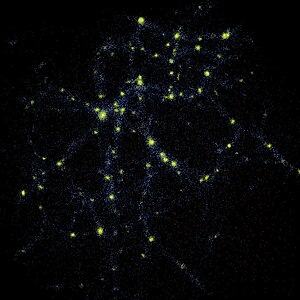Structure formation
| Part of a series on |
| Physical cosmology |
|---|
In physical cosmology, structure formation is the formation of galaxies, galaxy clusters and larger structures from small early density fluctuations. The universe, as is now known from observations of the cosmic microwave background radiation, began in a hot, dense, nearly uniform state approximately 13.8 billion years ago.[1] However, looking at the night sky today, structures on all scales can be seen, from stars and planets to galaxies. On even larger scales, galaxy clusters and sheet-like structures of galaxies are separated by enormous voids containing few galaxies.[2] Structure formation attempts to model how these structures were formed by gravitational instability of small early ripples in spacetime density[3][4][5][6] or another emergence.[7]
The modern
Overview
Under present models, the structure of the visible universe was formed in the following stages:
Very early universe
In this stage, some mechanism, such as
Growth of structure
The early universe was dominated by radiation; in this case density fluctuations larger than the cosmic horizon grow proportional to the scale factor, as the gravitational potential fluctuations remain constant. Structures smaller than the horizon remained essentially frozen due to radiation domination impeding growth. As the universe expanded, the density of radiation drops faster than matter (due to redshifting of photon energy); this led to a crossover called matter-radiation equality at ~ 50,000 years after the Big Bang. After this all dark matter ripples could grow freely, forming seeds into which the baryons could later fall. The
Recombination
The universe was dominated by radiation for most of this stage, and due to the intense heat and radiation, the primordial hydrogen and helium were fully ionized into nuclei and free electrons. In this hot and dense situation, the radiation (photons) could not travel far before
), have detected very slight variations in the density and temperature of the CMB. These variations were subtle, and the CMB appears very nearly uniformly the same in every direction. However, the slight temperature variations of order a few parts in 100,000 are of enormous importance, for they essentially were early "seeds" from which all subsequent complex structures in the universe ultimately developed.The theory of what happened after the universe's first 400,000 years is one of hierarchical structure formation: the smaller gravitationally bound structures such as matter peaks containing the first stars and stellar clusters formed first, and these subsequently merged with gas and dark matter to form galaxies, followed by
Very early universe
The very early universe is still a poorly understood epoch, from the viewpoint of fundamental physics. The prevailing theory,
These perturbations are thought to have a very specific character: they form a
Other theories of the very early universe have been proposed that are claimed to make similar predictions, such as the brane gas cosmology,
The horizon problem

An important concept in structure formation is the notion of the
The
Primordial plasma
The end of inflation is called
Acoustic oscillations
The primordial plasma would have had very slight overdensities of matter, thought to have derived from the enlargement of quantum fluctuations during inflation. Whatever the source, these overdensities gravitationally attract matter. But the intense heat of the near constant photon-matter interactions of this epoch rather forcefully seeks thermal equilibrium, which creates a large amount of outward pressure. These counteracting forces of gravity and pressure create oscillations, analogous to sound waves created in air by pressure differences.
These perturbations are important, as they are responsible for the subtle physics that result in the cosmic microwave background anisotropy. In this epoch, the amplitude of perturbations that enter the horizon oscillate sinusoidally, with dense regions becoming more rarefied and then becoming dense again, with a frequency which is related to the size of the perturbation. If the perturbation oscillates an integral or half-integral number of times between coming into the horizon and recombination, it appears as an acoustic peak of the cosmic microwave background anisotropy. (A half-oscillation, in which a dense region becomes a rarefied region or vice versa, appears as a peak because the anisotropy is displayed as a power spectrum, so underdensities contribute to the power just as much as overdensities.) The physics that determines the detailed peak structure of the microwave background is complicated, but these oscillations provide the essence.[9][10][11][12][13]
Linear structure

One of the key realizations made by cosmologists in the 1970s and 1980s was that the majority of the
Dark matter plays a crucial role in structure formation because it feels only the force of gravity: the gravitational
The physics of structure formation in this epoch is particularly simple, as dark matter perturbations with different wavelengths evolve independently. As the Hubble radius grows in the expanding universe, it encompasses larger and larger disturbances. During matter domination, all causal dark matter perturbations grow through gravitational clustering. However, the shorter-wavelength perturbations that are included during radiation domination have their growth retarded until matter domination. At this stage, luminous, baryonic matter is expected to mirror the evolution of the dark matter simply, and their distributions should closely trace one another.
It is straightforward to calculate this "linear power spectrum" and, as a tool for cosmology, it is of comparable importance to the cosmic microwave background. Galaxy surveys have measured the power spectrum, such as the Sloan Digital Sky Survey, and by surveys of the Lyman-α forest. Since these studies observe radiation emitted from galaxies and quasars, they do not directly measure the dark matter, but the large-scale distribution of galaxies (and of absorption lines in the Lyman-α forest) is expected to mirror the distribution of dark matter closely. This depends on the fact that galaxies will be larger and more numerous in denser parts of the universe, whereas they will be comparatively scarce in rarefied regions.
Nonlinear structure
When the perturbations have grown sufficiently, a small region might become substantially denser than the mean density of the universe. At this point, the physics involved becomes substantially more complicated. When the deviations from homogeneity are small, the dark matter may be treated as a pressureless fluid and evolves by very simple equations. In regions which are significantly denser than the background, the full Newtonian theory of gravity must be included. (The Newtonian theory is appropriate because the masses involved are much less than those required to form a
The result of N-body simulations suggests that the universe is composed largely of
Gas evolution
The final stage in evolution comes when baryons condense in the centres of galaxy haloes to form galaxies, stars and
Modelling structure formation

Cosmological perturbations
Much of the difficulty, and many of the disputes, in understanding the large-scale structure of the universe can be resolved by better understanding the choice of
Inflation and initial conditions
The initial conditions for the universe are thought to arise from the scale invariant quantum mechanical fluctuations of
- ,
where is the three-dimensional Dirac delta function and is the length of . Moreover, the spectrum predicted by inflation is nearly
- ,
where is a small number. Finally, the initial conditions are adiabatic or isentropic, which means that the fractional perturbation in the entropy of each species of particle is equal. The resulting predictions fit very well with observations.
See also
- Big Bang – Physical theory describing the expansion of the universe
- Chronology of the universe – History and future of the universe
- Galaxy formation and evolution – From a homogeneous beginning, the formation of the first galaxies, the way galaxies change over time
- Illustris project – Computer-simulated universes
- Stellar evolution – Changes to stars over their lifespans
- Timeline of the Big Bang– History and future of the universe
References
- ^ "Cosmic Detectives". The European Space Agency (ESA). 2013-04-02. Retrieved 2013-04-15.
- Bibcode:1978IAUS...79..241J.
- ISBN 978-0-12-219141-1.
- ^ ISBN 978-0-521-57598-0.
- ISBN 978-0-521-42486-8.
- ISBN 978-0-691-08240-0.
- .
- ISBN 978-0-201-11604-5.
- .
- doi:10.1086/150713.
- .
- ^ R. A. Sunyaev, "Fluctuations of the microwave background radiation", in Large Scale Structure of the Universe ed. M. S. Longair and J. Einasto, 393. Dordrecht: Reidel 1978.
- S2CID 3015599.
- ^ Overbye, Dennis (15 April 2020). "Why The Big Bang Produced Something Rather Than Nothing - How did matter gain the edge over antimatter in the early universe? Maybe, just maybe, neutrinos". The New York Times. Retrieved 16 April 2020.
- S2CID 4383030.












